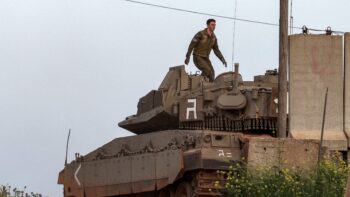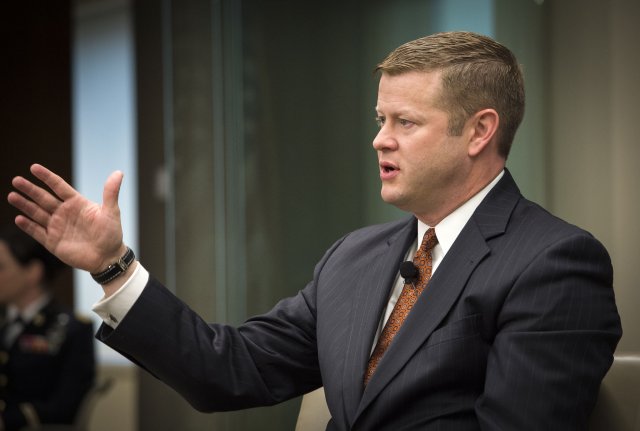
Ryan McCarthy
PENTAGON: Merry Christmas, US Army. As you read this, the White House Office of Management and Budget is reviewing the service’s draft spending plan for 2019-2023, which reshuffles more than a billion dollars in science and technology funds, undersecretary of the Army Ryan McCarthy told me in an exclusive interview. The goal: to better resource the Big Six modernization priorities he and Chief of Staff Mark Milley announced in October.
“I personally led those meetings. We had all the Army staff components, secretariat, all the directors of the labs, PEOs (Program Executive Officers), they all came in and we did a realignment of the entire S&T portfolio,” McCarthy told me. “I picked this project over that project….winners and losers.”
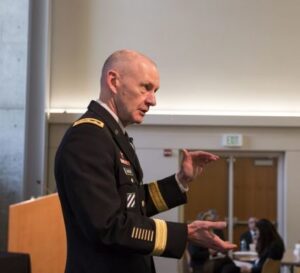
Lt. Gen. Edward Cardon
McCarthy’s next round of tough choices begins next week, when Lt. Gen. Edward Cardon submits the rough draft of the biggest change in how the Army buys equipment in 40 years. Next summer, the service will stand up what’s now being called Futures & Modernization Command (FMC) to unify its sprawling system for thinking about and equipping for the future.
There’s a legion of devils in the details to deal with, however, which Cardon and his staff are developing recommendations on. “We’ll have our first look at them right before Christmas,” McCarthy told me. “Then we’ll have those formal decisions teed up again in the January, early February timeframe.”
With all this work to do, McCarthy acknowledged, he won’t spend much time with his family this Christmas. “I’ll be sitting in the lodge, probably, with exciting reading material about the restructuring of the US Army,” he said.
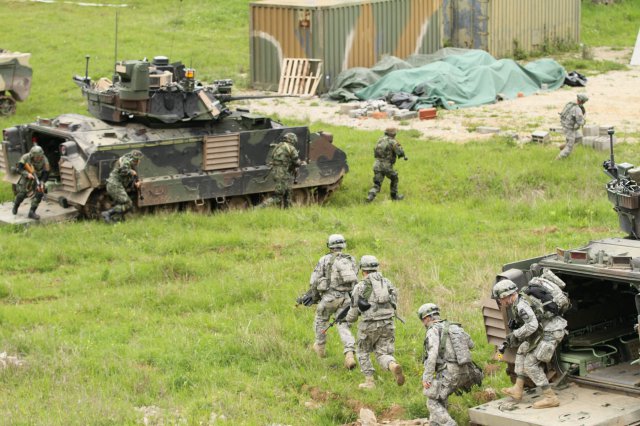
Army troops dismount their M2 Bradleys in a simulated assault. This kind of combined-arms attack — with, say, foot troops and vehicles fighting together — is standard on the battlefield but rare in the bureaucracy, which keeps different specialties isolated rather than working together.
Cross-Functional Teams
One central reorganization is already done. The service has set up elite Cross-Functional Teams — each one bringing together futurists, scientists, engineers, combat veterans, acquisition officials, and other experts from across the Army — for each of the Big Six modernization priorities. Those are, in order of importance:
- Long-range missiles
- New armored vehicles
- High-speed replacements for current helicopters
- Secure command networks
- Anti-aircraft and missile defense
- Soldier equipment.
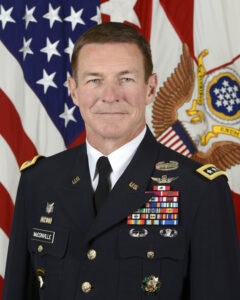
Gen. James McConville
The Cross-Functional Teams will form the core of the future Futures Command. In a sign of how seriously the service is taking the CFTs, each is led by a combat veteran who’s commanded a brigade and risen to general officer rank. The original plan was for CFT leaders to be one-stars but some are actually two-stars, McCarthy said: “We made it entirely about the individual,” not the rank. Vice-Chief of Staff James McConville played the leading role in picking the team leaders, with input from Gen. Milley and McCarthy.
Today, “the CFTs are off and working,” McCarthy said. “They’re going to be coming in here in a week to go through their charters” and to thrash out priorities within each of the Big Six portfolios.
The nascent teams even had a supporting role in the recent science and technology review, McCarthy said. “They participated but they were more in a listening mode, (though) some of them were in a position to weigh in on a couple subjects,” he told me. “In the future the CFTs will have even a greater role… and they will influence the recommendations for investments.”
“Where you’ll see the CFTs play the most and most aggressively is in the FY20 (budget) process,” which begins in earnest next year, McCarthy said. “Their charters will be approved, they’ll be task organized against the problem set, and they’ll have the amount of time that they need to perform the analysis against the capabilities and make an informed decision that this is [priority no.] 1, this is 2, this is n.”
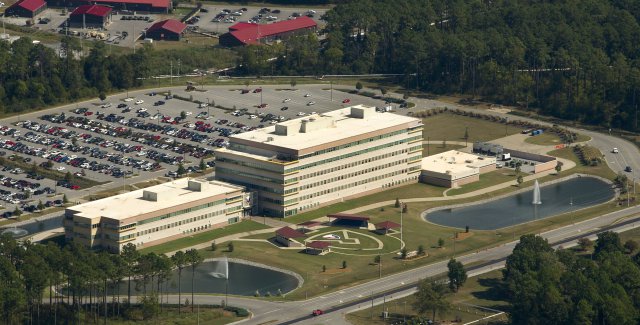
Army Materiel Command HQ at Redstone Arsenal, Ala.
Futures & Modernization Command
While the Cross-Functional Teams are already at work, the larger Futures & Modernization Command is still being designed.
“Gen. Cardon is working the larger restructuring recommendations,” McCarthy said. “The Vice Chief of Staff and I drive this process, so we meet with him every week.”
In November, McCarthy said, “we expanded his charter because we wanted to make sure everyone understood he had the authorities he needed to make recommendations that could alter the fundamentals of other major commands like a TRADOC (Training & Doctrine Command), like an AMC (Army Materiel Command).” Cardon needs to be able to say, “‘I need this piece of that command, this piece of that command’ and tie that together under one roof.”

Training & Doctrine Command (TRADOC) headquarters on Fort Eustis, Virginia
The Army’s current division of labor, which has endured four decades, tasks TRADOC to think about future warfare, develop concepts and doctrine, oversee training, and write requirements for new equipment. Those requirements then go to Army Materiel Command, which actually researches new technologies and develops weapons, fields them, and sustains them with spare parts and upgrades. (To make matters more complicated, by law, AMC’s Program Executive Officers also report directly to the civilian Assistant Secretary for Acquisition, Logistics, & Technology). TRADOC and AMC each have their own complex internal divisions of labor as well. As a result, it can take years or decades for troops saying “we need X” to work its way through the system from concept to requirement to contract and emerge as something the troops can use.
There’ve been many attempts to bridge the divide, but the fundamental bifurcation endures. “I believe bringing requirements and the technical community together…. will simplify the requirements process,” McCarthy said. “Today requirements people work on something for a while and then they send it over the transom to somebody else, (and) they go back and forth….By bringing them together you can work the tradeoffs on the front end.”
Taking modernization-related functions away from TRADOC and AMC will still leave those commands with plenty to do, McCarthy argues. “This gives focus and clarity to the commands. You look at all of the things that TRADOC does — all of the training and doctrine and futures — that’s a lot.. (The reform) it will actually take away the burden of these responsibilities from the major commands and help tighten the focus.”

Ryan McCarthy takes a selfie with ROTC cadets. The Army will need to make the most of its young, tech-savvy talent as it struggles to modernize.
Streamlined & Talented
Adding a new command will not add bureaucracy, McCarthy contends, because it can start out as a relatively lean headquarters organization. Existing laboratories, program management offices, concept development staffs, and so on can report to this new HQ without physically relocating and losing their connection to the organizations they are part of today.
“The talent lives where the talent lives, I just want it to work for a different person,” McCarthy said. “We’re not looking at moving people all around the country.”
“The headquarters command element, that might a small subset of people that are living in a certain place….That is the connection to industry, academia, and the outside world,” McCarthy said. “The arms and legs of this organization will exist in other places in the country.”

A soldier holds a PD-100 mini-drone during the PACMAN-I experiment in Hawaii.
How exactly this will work remains a work in progress. “There are various models of how to organize,” McCarthy said. “You look at other major commands of other services, or in the defense industry (like) the legendary Skunk Works.”
“But it always comes down to people,” McCarthy said. “I’ve even gotten in the mode where I’m recruiting people.”
Consider Hyman Rickover, the famously driven admiral who led the US Navy into the nuclear age, McCarthy said. (Yes, despite two centuries of “beat Navy,” the Army is now looking at the Navy and for that matter the Air Force for inspiration). “if you read anything about Rickover, he went around and recruited the absolute best and brightest minds in the Navy, and then he went out into academia and he got the best and brightest people in academia, and he built an incredible team,” McCarthy said. That’s the model the Army needs to follow.
“We’ve looked at the authorities that were granted to us by the National Defense Authorization Act (for) hiring,” McCarthy said. “Where are these people in the country, because some of them might not be in the military, they’re civilians, they may be in academe or industry. How do we go get them? How do we hire them quickly? And how do incentivize them in such a way so they’ll want to join the team?”
“It’s all about culture to me. What is the culture of this organization? What are the kinds of people we wan to attract?” McCarthy said. “If it’s just like another Army headquarters, well, you can have people who are army-centric. (But) we need to have different types of thinking.”
Norway’s top officer on his ‘biggest challenge,’ next frigate and new NATO neighbors
Gen. Eirik Kristoffersen, Norway’s Chief of Defense, talks to Breaking Defense about his plans for spending on new frigates and subs, the challenges of upgrading Norway’s “digital backbone” and refilling the military’s stocks.






















